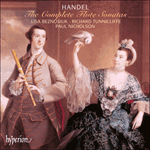There is no particular reason to be sceptical over the authorship of this sonata. The bold line at the opening, with its falling sevenths at the start, its passing into the bass, and the persistent treatment of the rhythm—all these are Handelian hallmarks and the kind of gesture that few other composers of the time would dare. The Allegro too is well worked, with the continuo constantly pursuing the flute (and occasionally giving up). The Adagio has some telling touches, and a resourceful bass line. But it is the finale, with its striking rhythms, its leaping line and its repeated-note figure—a figure Handel uses a great deal at expressive climaxes in his operas—that seems to set the Handelian seal unmistakably on this music.
from notes by Stanley Sadie © 2001
Nous n’avons pas de raison particulière de douter de la paternité de cette sonate. La hardiesse de la mélodie initiale, commençant par des intervalles de septième descendante, son passage à la basse et le traitement persistant du rythme sont autant de signatures haendéliennes, et le genre de procédés que peu d’autres compositeurs de l’époque auraient osé adopter. L’Allegro est également de belle facture, le continuo pourchassant constamment la flûte (abandonnant parfois aussi). L’Adagio présente quelques touches éloquentes et une ligne de basse pleine de ressources. Mais c’est le finale, avec ses rythmes saisissants, sa ligne bondissante et son motif en notes répétées—motif abondamment utilisé par Haendel aux points culminants de ses opéras—qui marque cette musique d’un sceau indubitablement haendélien.
extrait des notes rédigées par Stanley Sadie © 2001
Français: Josée Bégaud
Es gibt eigentlich keinen Grund, die Urheberschaft dieser Sonate mit Skepsis zu betrachten. Die kühne Linie am Anfang, die mit abfallenden Septimen einsetzt, um später in den Baß überzutreten, und die nachdrückliche Behandlung des Rhythmus sind allesamt kennzeichnend für Händel und bilden jene Art von Geste, die sich wenige andere Komponisten der Epoche zugetraut hätten. Auch das Allegro ist gut durchgeführt, wobei der Continuo ständig die Flöte verfolgt (um gelegentlich aufzugeben). Das Adagio weist einige wirkungsvolle Feinheiten und eine einfallsreiche Baßlinie auf. Aber es ist das Finale mit seinen bemerkenswerten Rhythmen, der Melodielinie voller Sprünge und der Figur aus wiederholten Noten—wie sie Händel oft an den ausdrucksvollen Höhepunkten seiner Opern einsetzt—, das dieser Musik den unverwechselbar Händelschen Stempel aufzudrücken scheint.
aus dem Begleittext von Stanley Sadie © 2001
Deutsch: Anne Steeb/Bernd Müller


 Handel: The Complete Flute Sonatas
Handel: The Complete Flute Sonatas
